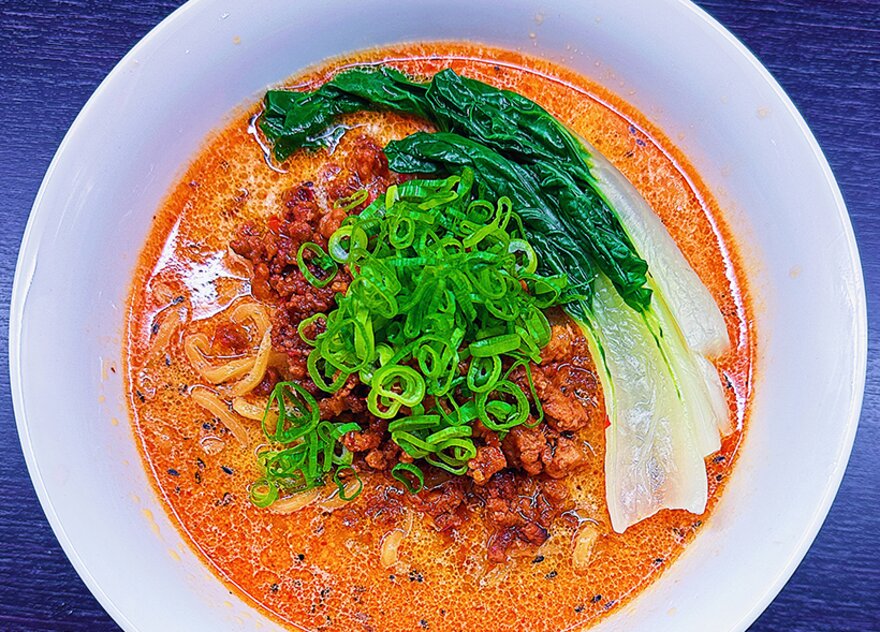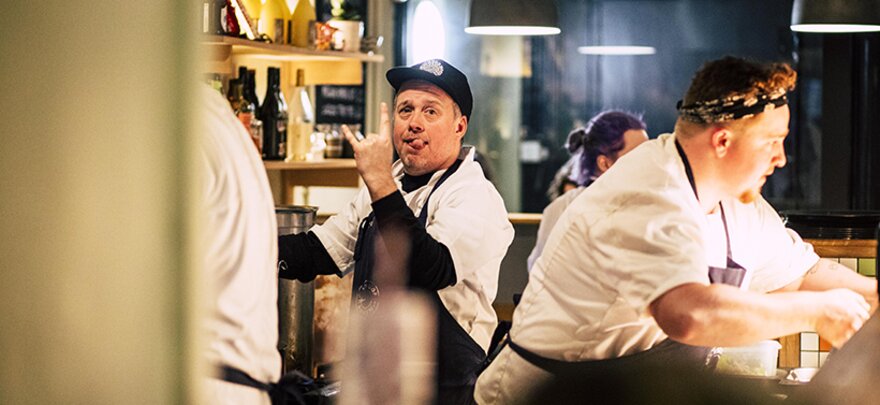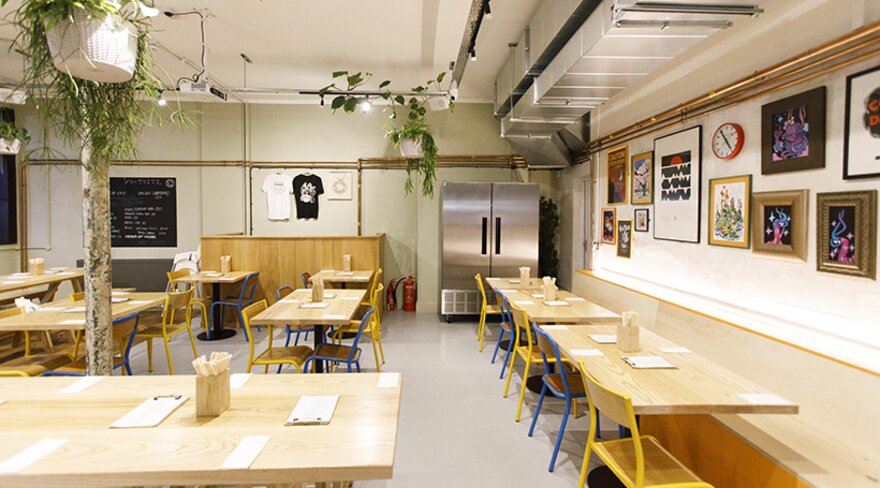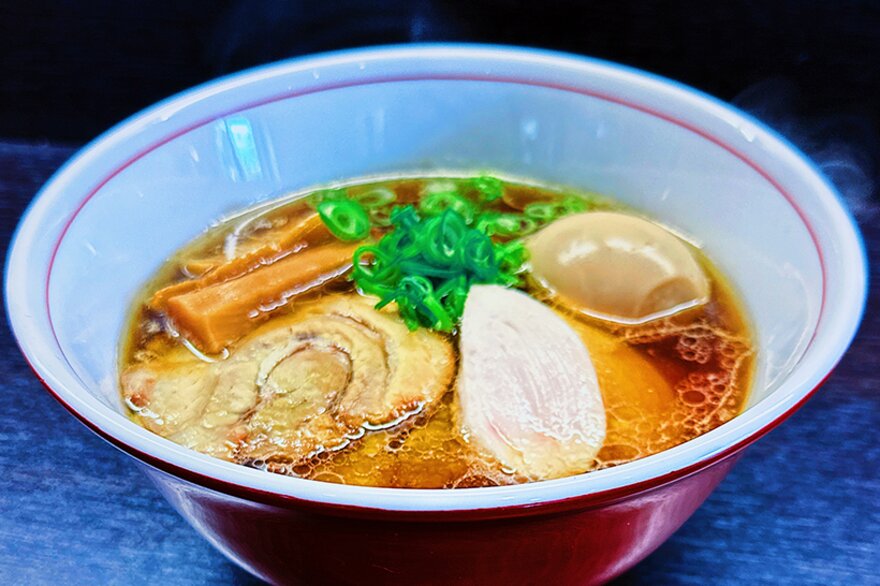A bowl of noodles sent James Chant's life in a totally different direction. Caroline Baldwin meets the brains behind the Cardiff ramen business
Serendipity has a lot to do with the explosion of his business over the past few years, says creative director and owner of Matsudai Ramen, James Chant.
His career in the music and events industries was no longer giving him joy so, fast-forward five years, and with no chef training, he opened a restaurant in Cardiff's Grangetown – which, as far as he can tell, is the only standalone ramen shop in Wales, and one that counts Observer food critic Jay Rayner as a fan.
"I got to a point in 2018 where I had turned 40, lost my job, got married and moved house all in one week – so really we were born out of a mental health crisis," says Chant. The chef had previously dabbled in design and video editing, while enjoying cooking at home in his spare time.
Although he had developed an appreciation for Japanese food from tours in his music days, his love for ramen came about after eating a bowlful in a Japanese restaurant in Cheltenham – "which, looking back, was really awful, but interesting enough to pique my interest".
The self-confessed ramen geek was born and Chant went down a rabbit hole, experimenting with dozens of recipes and spending hours online researching, pausing YouTube videos of Japanese noodle shops at certain frames so he could read the menus written on the walls to discover new ingredients. "It was like unlocking a new secret level of a video game," he says.
"From a flavour point of view, ramen is so complicated and difficult to even find information on. The flavours can be quite confusing to the Western palate, but also really comforting and familiar at the same time, which is what lured me in," he said. "I had my eureka moment with a bowl of classic tonkotsu.
One day, after shooting in the dark and being as inquisitive as I could, I managed to get the recipe right."
An opportunity in 2019 to do a ramen pop-up in Cardiff turned into subsequent sell-out events, as well as a ramen kit business, which he continued to develop through lockdown and which sold out online each week. Meanwhile, collaborations with YouTuber Uncle Roger and MasterChef winner Tim Anderson has only added to Matsudai's success.
Chant is all too aware that he is a "middle-aged white guy from Wales" and he ensures the restaurant avoids Japanese cliches, instead using punchy branding (designed by Chant himself), including the circular Matsudai logo, that is printed on T-shirts and tote bags, which are sold online and in the restaurant. His ‘Forever and ever ramen' graphic led to the name Matsudai – which means ‘perpetuity' in Japanese. The 1,700 sq ft former NatWest Bank, which is now home to his ramen shop, has framed graphic prints adorning the concrete walls, including one poster declaring ‘Coal Not Dole', harking back to the 1980s miners' strikes in the Welsh Valleys. "The restaurant really has got me written all over it," he says.
Prep to plate
There are four main types of ramen – miso, shoyu, shio and tonkotsu – which have all made their way on and off Matsudai's menus over the years, but his shoyu recipe is a classic that has never left. It starts with a chicken soup made from carcasses, chicken feet and vegetables, which simmers on low for six hours before skimming. A dashi sees dried sardines (niboshi), dried kelp (kombu) and dried shiitake mushrooms soaked overnight before being heated to 82ºC, as "each element has a different temperature where you extract the best flavour". He then removes the kombu before it becomes bitter and adds dried mackerel (sababushi) and dried tuna (katsuobushi) to boil before straining. "We soak the ingredients the night before, but cook the dashi just before service so it doesn't lose its potency."
A tare (Japanese for sauce) forms the base of each ramen, with Matsudai's shoyu tare taking 10 days to make from three soy sauces, which again are bought to different temperatures at different times to develop the right flavours. "Ramen is a very prep-heavy thing, while the service is quick" he says, and a reworked menu has been designed to simplify that service. The kitchen preps one clear, golden chicken-based soup, one seafood dashi and a vegan version made from shiitake mushrooms and kombu, which is mixed with soy milk. "There are limitless variations and we're constantly trying to improve," he says.
Since Rayner described Matsudai's ramen as "bowls of deep care and thoughtfulness" in a glowing review back in February, the restaurant has seen bookings "wall-to-wall", says Chant, which is more than welcome to help weather the storm when it comes to energy bills and the cost of living crisis. The signature shoyu starts at £14, while small plates include the likes of a cucumber sunomono salad with a sweet-savoury-spicy sesame dressing or triple-fried karaage chicken. The mushroom version of the karaage is made from oyster mushrooms torn by hand to create "scraggly ends", before being marinaded in tamari, mirin, sugar and shichimi. The almost squid-like results are then dredged in potato and cornflour and fried three times.
"It comes with a curry mayo made from egg yolks, rice vinegar, Dijon mustard, seasoning and has curry powder sifted through it. It's almost become our signature – people go mad for it," says Chant. He is in the kitchen a couple of days a week, while kitchen lead Jordon Griffiths, former head chef at Nook in Cardiff, looks after the pass and translates Chant's thoroughly researched kitchen table recipes into scalable quantities for a commercial kitchen.
Another small plate is the lamb gyozas (see panel) – a dish resulting from his collaboration with Anderson made from Welsh lamb, leek and rayu furikake. Traditional furikake is a Japanese seasoning sprinkled on a dish to increase the umami flavour, and is often made from nori, sesame, fish flakes and sometimes dried plums, mushrooms, dried egg or shiso. However, rayu furikake is a chilli seasoning that uses the leftover spices from Matsudai's house chilli oil, which would normally be discarded after straining. "Instead of throwing it away we dry the ingredients as much as possible and use them in the dumplings," says Chant. The gyozas are steamed and then fried in Caerphilly cheese to create a crispy ‘skirt', and served with a tamari-vinegar dipping sauce.
The gyoza is a nod to not only his Welsh roots, but his intent to localise his dishies as much as possible, which is easier said than done when he depends on core Japanese ingredients that are shipped in monthly from a friend living in Tokyo.
"The local Welsh ingredients aren't up to scratch yet," he says. "It's not that the seafood isn't great, it's just the process, because there's no call for smoked fermented fish flakes in Cardiff at the moment."
Ramen on a roll
Chant has dreams of opening up another kitchen to focus on developing these crucial ramen ingredients a bit closer to home, potentially transforming Welsh seaweed into a kombu, or developing good quality soy sauces to sell online alongside his meal kits and merchandise. Scaling the brand further with a site in London after a successful pop-up at the end of 2021 is firmly in his mind's eye, and opening a ramen school is also on the cards. "I have so many ideas, I need to catch up with myself," he says.
One plan that is finally coming to fruition is making noodles in-house. Rather than relying on a third party to make them from Chant's recipe (which he is constantly tweaking), he has now hired pastry chef George Davies and specialist equipment has been purchased.
And while some might think ramen is all about the crispy seaweed sheet sticking out of the soup, or the shiny umami soy egg with its gooey centre (see panel), Chant says the toppings are actually the least important part – instead, the noodle takes centre stage and they require his attention to detail to get exactly right.
"Ramen is defined by the noodle and has to be made with a kansui, which is an alkaline solution, which gives the noodle a slightly soapy smell that is definitive of ramen. And with a tiny change of just 0.1% to that sodium carbonate potassium it can affect the gluten structure of the noodle make it too toothy or soft," he explains.
"The kansui isn't the only variable – hydration, flour choice, egg powders and vital wheat gluten also impact the noodle, but it's the kansui that gives the ramen noodles bite, makes htem snappy, and stops them from dissolving in the hot soup. It can also turn the noodles slightly yellow and gives them a mildly sulphuric flavour."
And it's exactly this level of detail that is going to see Matsudai continue to make waves in the food world. (R)amen to that.
From the menu
Small plates
- Karaage chicken
- Karaage mushroom
- Lamb gyoza
- Mini chashu don
- Cucumber sunomono
- Shiitake shoyuzuke
Ramen
- Signature shoyu
- Shirunashi mazesoba
- Tantanmen
- Yasau tantanmen
Extra toppings
- Braised chashu pork belly
- Sous vide chicken breast
- Seasoned ajitama egg
- Organic tofu chashu
- House menma (bamboo)
- Nori (roasted seaweed)
Spicy lamb and rayu gyoza
Makes approximately 15 dumplings
- 150g lamb mince
- 60g cabbage
- 3 finely sliced spring onions
- 1tbs minced ginger
- 2 minced garlic cloves
- 1tbs soy sauce
- 1tsp sugar
- 1tbs rayu solids (replace with ½tbs of shichimi togarashi plus ½tbs of your choice of furikake)
- 1 good pinch white pepper
- 15 gyoza wrappers
- 200g Caerphilly cheese (or good Cheddar)
Cook cabbage in boiling salted water for one minute. Drain and then rinse under cold running water. Pat the cabbage dry and then finely chop. Combine the cabbage with the lamb mince, spring onions, ginger, garlic, soy sauce, salt, sugar, pepper and sesame oil, mixing well by hand.
Lay out the gyoza wrappers. Dip your finger in water and run it around half of the outer rim of each wrapper. Place 1 tablespoon of the filling in the middle of the wrapper and bring up the edges to join. Pleat the top, pressing firmly to seal.
Heat a tablespoon of oil in a non-stick frying pan on medium heat and grate in a thin layer of cheese.
Place the gyoza in the cheese, flat side-down, and cook until the cheese is golden brown, about one minute.
Pour 150ml hot water down the side of the pan, cover, and steam over a low heat until the water dries up, about five minutes.
Uncover, and allow the gyoza to fry until the water has dissolved and the bottoms of the gyoza and cheese are crisp and brown – usually around one minute.
Serve with a dipping sauce of soy sauce and vinegar (1:1:1 mix of water and soy sauce and either black, rice, or apple cider vinegar).
Ajitsuke tamago (ajitama ramen eggs)
- 6 large, fresh, refrigerated eggs
- 500ml water
- 105ml Japanese soy sauce
- 90ml mirin
Bring a pot of water to a boil – it should be large enough that it doesn't stop boiling when you add the eggs.
Optionally, pierce a hole in the fat end of each egg using a drawing pin, so that they cook more evenly.
Cook the eggs for 7 minutes at a rolling boil, moving around gently for the first minute or so, which will centre the yolk.
Remove the eggs from the water and cool in iced water (or in cold water, changing regularly) for 20 minutes.
Peel the eggs – if you peel them under water it will help the shells to come away more cleanly and easily.
Combine the remaining ingredients to make the marinade. Place the eggs and marinade in an container. Leave in the fridge for at least 48 hours (we like to leave them for 3-4 days). Use within five days.
Continue reading
You need to be a premium member to view this. Subscribe from just 99p per week.
Already subscribed? Log In













